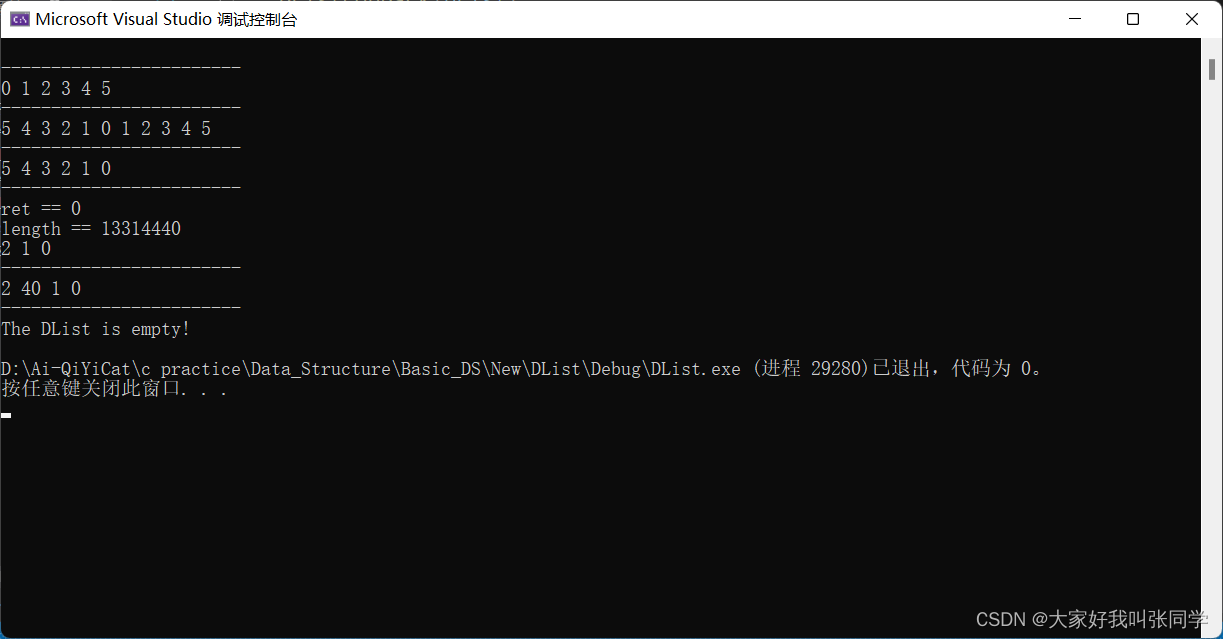链表根据带头不带头、单向或双向、循环非循环三个方面可组成成八种类型。这八种类型中仅有两种是我们常用的。
第一种是单向不带头非循环链表,也就是单链表。单链表因为结构简单,但是实际操作比较复杂,所以在面试当中经常被用到,(因为可以考察出同学们的水平和能力呀~)。如果我们经常在leetcode或者牛客网等刷题网站上面玩耍,就可以遇到大量与单链表相关的题目。如果想复习或进一步学习单链表的内容,可以参考文章【数据结构学习笔记】二、线性表—链表篇(2)
第二种是双向带头循环链表,也被叫做双链表。这种链表虽然结构比较复杂,(又是双向,又是带头,又是循环,看起来结构好像很复杂的样子)但是实际操作却非常简单。因此在我们的实际工作或项目中常使用的链表是这种。

头文件
DList.h
#pragma once
#include<stdio.h>
#include<stdlib.h>
#include<assert.h>
//双向带头循环链表
typedef int LTDatatype;
typedef struct DList
{
LTDatatype data;
struct DList* next;
struct DList* prev;
}DList,DNode;
//创建一个节点
DNode* CreateDNode(LTDatatype x);
//链表初始化
DList* DListInit();
//销毁
void DListDestory(DList** pphead);
//打印
void DListPrint(DList* phead);
//尾插
void DListPushBack(DList* phead,LTDatatype x);
//头插
void DListPushFront(DList* phead, LTDatatype x);
//尾删
void DListPopBack(DList* phead);
//头删
void DListPopFront(DList* phead);
//查找
DNode* DListFind(DList* phead, LTDatatype x);
//在任意位置插入
void DListInsert(DNode* pos, LTDatatype x);
//在任意位置删除
void DListErase(DNode* pos);
//判空 1-为空 0-非空
int DListEmpty(DList* phead);
//求长度
int DListLength(DList* phead);
源文件
DList.c
#include"DList.h"
//创建一个节点
DNode* CreateDNode(LTDatatype x){
DNode* node = (DNode*)malloc(sizeof(DNode));
if (node == NULL)
{
printf("malloc fail!\n");
return NULL;
}
node->data = x;
node->next = NULL;
node->prev = NULL;
return node;
}
//链表初始化
DList* DListInit(){
DNode* phead = CreateDNode(0);
phead->next = phead;
phead->prev = phead;
return phead;
}
//销毁
void DListDestory(DList** pphead){
assert(pphead);
DNode* cur = (*pphead)->next;
DNode* next = NULL;
while (cur != *pphead)
{
next = cur->next;
free(cur);
cur = next;
}
*pphead = NULL;
}
//打印
void DListPrint(DList* phead){
if (phead == NULL)
{
printf("The DList is empty!\n");
return;
}
DNode* cur = phead->next;
while (cur != phead)
{
printf("%d ", cur->data);
cur = cur->next;
}
printf("\n------------------------\n");
}
//尾插
void DListPushBack(DList* phead, LTDatatype x){
1.找到尾巴
//DNode* tail = phead->prev;
2.申请一个节点
//DNode* newnode = CreateDNode(x);
3.进行尾插操作
//tail->next = newnode;
//newnode->prev = tail;
//newnode->next = phead;
//phead->prev = newnode;
DListInsert(phead, x);
}
//头插
void DListPushFront(DList* phead, LTDatatype x){
//assert(phead);
//DNode* newnode = CreateDNode(x);
//DNode* pnext = phead->next;
//newnode->next = pnext;
//newnode->prev = phead;
//pnext->prev = newnode;
//phead->next = newnode;
DListInsert(phead->next, x);
}
//尾删
void DListPopBack(DList* phead){
链表为空,或链表仅有头节点
//if (phead == NULL || phead->next == phead)
//{
// printf("No element to pop!\n");
// return;
//}
//DNode* tail = phead->prev;
//DNode* prev_tail = tail -> prev;
尾删操作
//prev_tail->next = phead;
//phead->prev = prev_tail;
//free(tail);
//tail = NULL;
DListErase(phead->prev);//接口复用
}
//头删
void DListPopFront(DList* phead){
//assert(phead && (phead->next != phead));
//DNode* first = phead->next;
//DNode* second = first->next;
头插操作
//second->prev = phead;
//phead->next = second;
//free(first);
//first = NULL;
DListErase(phead->next);//接口复用
}
//查找
DNode* DListFind(DList* phead, LTDatatype x){
assert(phead);
DNode* cur = phead->next;
while (cur != phead)
{
if (cur->data == x)
return cur;
cur = cur->next;
}
return NULL;//查找不到就返回NULL
}
//在任意位置插入--前面插入
void DListInsert(DNode* pos, LTDatatype x){
assert(pos);
DNode* prev = pos->prev;
DNode* newnode = CreateDNode(x);
newnode->next = pos;
newnode->prev = prev;
pos->prev = newnode;
prev->next = newnode;
}
//在任意位置删除
void DListErase(DNode* pos){
assert(pos && pos->next != pos);
DNode* prev = pos->prev;
DNode* next = pos->next;
prev->next = next;
next->prev = prev;
free(pos);
pos = NULL;
}
//判空 1-为空 0-非空
int DListEmpty(DList* phead){
return phead->next == phead ? 1 : 0;
}
//求长度
int DListLength(DList* phead){
int length = 0;
DNode* cur = phead->next;
while (cur != phead)
{
cur = cur->next;
length++;
}
}
测试模块
test.c
#define _CRT_SECURE_NO_WARNINGS 1
#include"DList.h"
void TestDList1(){
DList* pList = DListInit();
DListPrint(pList);
DListPushBack(pList, 0);
DListPushBack(pList, 1);
DListPushBack(pList, 2);
DListPushBack(pList, 3);
DListPushBack(pList, 4);
DListPushBack(pList, 5);
DListPrint(pList);
DListPushFront(pList, 1);
DListPushFront(pList, 2);
DListPushFront(pList, 3);
DListPushFront(pList, 4);
DListPushFront(pList, 5);
DListPrint(pList);
DListPopBack(pList);
DListPopBack(pList);
DListPopBack(pList);
DListPopBack(pList);
DListPopBack(pList);
DListPrint(pList);
int ret = DListEmpty(pList);
printf("ret == %d\n", ret);
int length = DListLength(pList);
printf("length == %d\n", length);
DListPopFront(pList);
DListPopFront(pList);
DListPopFront(pList);
DListPrint(pList);
DNode* pos = DListFind(pList, 1);
if (pos)
{
DListInsert(pos, 40);
}
DListPrint(pList);
DListDestory(&pList);
DListPrint(pList);
}
int main()
{
TestDList1();
return 0;
}
运行截图
